Abstract
In this study, a novel magnetic nanocatalyst based on tin ferrite (SnFe2O4) was synthesized via a chemical co-precipitation method and thoroughly characterized using XRD, SEM, TGA-DTG, BET, FTIR, and FTIR-pyridine techniques. The catalyst exhibited high crystallinity, a mesoporous structure with a specific surface area of 79.7 m2/g, and well-defined Lewis and Brønsted acid sites. Its catalytic performance was assessed in the esterification of glycerol with acetic acid to produce monoacetin (MAG), diacetin (DAG), and triacetin (TAG). A Box–Behnken experimental design was employed to evaluate the influence of temperature, catalyst loading, and the acetic-acid-to-glycerol molar ratio on product distribution and glycerol conversion. Statistical analysis and regression modeling revealed excellent predictive accuracy (R2 > 0.99), confirming the robustness of the model. Optimal reaction conditions (110 °C, 2 wt.% catalyst, and AA/GLY ratio of 3.6) yielded a maximum glycerol conversion of 93.2% and a combined DAG and TAG yield of ~59.1%. These results demonstrate the high efficiency and selectivity of the synthesized SnFe2O4 catalyst, making it a promising candidate for sustainable glycerol valorization.
1. Introduction
The growing demand for biodiesel within the fuel market has resulted in a significant accumulation of glycerin, a by-product of the transesterification process used in biodiesel production. This surplus of glycerin has spurred research into various methodologies for its effective utilization, thereby transforming what started as a waste product into a valuable resource [1,2,3]. Recently, glycerol has gained widespread use as a plasticizer due to its low cost and availability as a surplus by-product of biodiesel production [4]. Several efforts have been made to explore its potential as a precursor for producing plasticizers and for use in polymers such as glyceryl triacetate (TAG) [5,6].
Glyceryl triacetate is a low-molecular-weight, non-toxic oily liquid plasticizer approved for food applications [7]. It has been utilized as a plasticizer and processing aid to facilitate the dispersion of nanofibers and serve as a liquid medium for their feeding in PLA. Due to polar interactions between the ester groups, TAG is miscible with PLA [8]. Numerous studies have demonstrated the effectiveness of TAG as a plasticizer in enhancing the thermal and mechanical properties of PLA. For instance, the addition of TAG (20%) increased the degree of crystallinity while decreasing optical transparency. Additionally, these additives positively impacted the mechanical properties, increasing the elongation at break from 2% to 31% and toughness from 1 MJ/m3 to 8 MJ/m3 [8]. In a study by Arias et al. [9], it was revealed that the glass transition temperature (Tg) of PLA decreased by 8 °C with the addition of 10% TAG, while the degree of crystallinity increased by 7.5%. Furthermore, the melting temperature rose by 5.6 °C. The tensile strength of PLA significantly improved, increasing from approximately 6 MPa to 30.9 MPa. Additionally, TAG enhanced the elongation at break of pure PLA (εb 2.4%) by 21 times its original value. In another study, the addition of 10 wt.% TAG improved the ductility of PLA films for packaging applications but reduced the tensile modulus from 2.40 GPa to 0.75 GPa and the tensile strength from 47 MPa to 27 MPa. However, the elongation at break increased from approximately 6% without TAG to 418% with the introduction of the plasticizer [10]. In a study by Salas-Papayanopolos et al. [11], the introduction of 10% TAG caused the glass transition temperature to decrease by 20 °C, and the crystallization temperature dropped by 12.5%. Similarly, the melting temperature decreased slightly from 174.8 °C to 171.0 °C. The storage modulus at 25 °C also declined from 1918 MPa to 1704 MPa. Additionally, the α-transition temperature decreased from 59.5 °C to 39.6 °C [11].
Traditionally, glyceryl acetates are produced through the acetylation of glycerol using either acetic acid or acetic anhydride. However, for practical applications, acetic acid is widely preferred due to its cost-effectiveness and environmental benefits [12]. In general, the esterification of glycerol with acetic acid involves consecutive and reversible three-step reactions that yield glyceryl monoacetate (MAG), glyceryl diacetate (DAG), and glyceryl triacetate (TAG) [13]. This reaction occurs in the presence of either homogeneous or heterogeneous catalysts. Mineral acid catalysts, such as H2SO4, H3PO4, HCl, and p-toluene sulphonic acid [14], are commonly used in esterification reactions. However, they present several disadvantages, including handling difficulties, corrosion issues, and non-reusability, as they must be quenched and neutralized, leading to large amounts of process waste [15]. Ionic liquids, such as nitrogen-based Brønsted-acidic ionic liquids [16], SO3H-functionalized ionic liquids [17], [HSO3-pmim][HSO4] [18], (3–sulfonic acid)–propyl-triethyl-ammonium chloroironinate [HO3S–(CH2)3–NEt3]Cl–[FeCl3]0.67 [19], and heteropolyacid-based ionic liquids incorporating pyridinium propyl sulfonate [20], exhibit promising catalytic activity. These alternatives to mineral acids are characterized by good thermal stability, ease of handling, and recyclability, making them attractive options [21]. Compared to reusable homogeneous catalysts, solid acid catalysts offer much easier separation from the reaction mixture via simple filtration. Moreover, they facilitate clean, selective reactions, yielding high-purity products [15]. Their key properties, such as acidity, catalyst texture, and surface characteristics, can be optimized to enhance glycerol conversion and selectivity for superior glycerol acetates. As a result, they have largely replaced traditional homogeneous acid catalysts due to environmental, technological, and economic advantages [22]. A wide variety of solid acid catalysts, including those based on transition metal oxides, have been investigated for the acetylation of glycerol.
Hu et al. [23] studied the esterification of glycerol with acetic acid using various metal oxides, including Bi2O3, Sb2O3, SnO2, TiO2, Nb2O5, and Sb2O5. Among these catalysts, Sb2O5 demonstrated the highest activity and selectivity toward diacetin, achieving a glycerol conversion of 96.8% and a diacetin selectivity of 54.2%. The selectivity for monoacetin and triacetin was 33.2% and 12.6%, respectively. In comparison, the other oxides showed a glycerol conversion of 45.2% and a diacetin selectivity of 12.6%. Kulkarni et al. [24] studied heterogeneous catalysts, including commercially procured CeO2 and ZrO2, as well as a CeO2-ZrO2 mixed metal oxide catalyst synthesized via the solution combustion method. They found that under optimal conditions—a temperature of 100 °C, 5 wt.% catalyst loading, and a glycerol-to-acetic-acid molar ratio of 1:10—the glycerol conversion rates were 81.8% for ZrO2, 75.6% for CeO2, and 62% for the CeO2-ZrO2 mixed metal oxide catalyst. The efficient and selective acetylation of glycerol using magnetic solid acids, specifically Fe-Sn-Ti(SO42−) calcined at 400 °C, was demonstrated by Sun et al. [25]. Under optimized conditions, 100% glycerol conversion and 99.0% selectivity for triacetin were achieved at 80 °C. Reddy et al. [26] investigated the acetylation of glycerol with acetic acid using various solid acid catalysts, including ZrO2, TiO2–ZrO2, WO3/TiO2–ZrO2, and MoO3/TiO2–ZrO2. Among these, the MoO3/TiO2–ZrO2 catalyst exhibited the best catalytic activity, achieving approximately 100% glycerol conversion and up to 80% selectivity for triacetin under optimal conditions (120 °C, a 6:1 acetic-acid-to-glycerol ratio, and 5 wt.% catalyst).
The goal of this study was to evaluate the catalytic activity of a novel magnetic nanocatalyst based on tin ferrite (SnFe2O4) for the glycerol acetylation process, as, to our knowledge, no similar catalyst has been used in the literature for this process. The catalyst was synthesized via a chemical co-precipitation method and thoroughly characterized using multiple techniques; lastly, its catalytic performance was assessed by a Box–Behnken experimental design approach.
SnFe2O4 exhibits magnetic properties, allowing for easy separation from the reaction mixture using an external magnetic field or by centrifugation due to its solid-phase nature. This contrasts with traditional homogeneous acid catalysts, which are difficult to recover and require complex post-reaction treatment. In addition, SnFe2O4 is safer and more environmentally benign, reducing corrosion risks and handling hazards associated with mineral acids such as H2SO4 and HCl [27]. The catalyst also demonstrates remarkable thermal stability at reaction temperatures up to 110 °C, as confirmed by TGA-DTG analysis, which showed weight loss below 1% attributed to moisture and surface-adsorbed volatiles. FTIR-pyridine analysis revealed the presence of both Brønsted and Lewis acid sites in a balanced ratio, making SnFe2O4 particularly suitable for the stepwise esterification of glycerol, unlike conventional acids that typically offer only Brønsted acidity. Furthermore, its mesoporous structure with an average pore diameter of 8.6 nm and a high surface area of 79.7 m2/g enhances reactant accessibility and promotes selectivity toward diacetin and triacetin, which is challenging to achieve using homogeneous systems. Ultimately, SnFe2O4 aligns with the green chemistry principles due to its reusability and reduced separation demands, positioning it as a promising catalyst for glycerol valorization in biofuel and bioproduct applications.
2. Materials and Methods
2.1. Materials
FeCl3·6H2O (Carl Roth, Karlsruhe, Germany, min. 98%), SnCl2·H2O (Merck KGaA, Darmstadt, Germany, ≥98%), glacial acetic acid (Merck, ≥99.7%), glycerol (Merck, Darmstadt, Germany, ≥99.5%), Amberlyst® 15 (dry) ion-exchange resin (Thermo Fischer Scientific, USA), cyclohexane (Merck, Darmstadt, Germany, ≥99%), heptane (Merck, Darmstadt, Germany, ≥96%), and toluene (Chemical Company, Iași, România ≥98%) were used in this study.
2.2. Catalysts’ Preparation
The catalyst SnFe2O4 magnetic nanoparticles were synthesized via chemical co-precipitation of chloride salts of Fe3+ and Sn2+ [28,29] in a 2:1 molar ratio. Specifically, 27.029 g of FeCl3·6H2O and 11.281 g of SnCl2·H2O were dissolved in 350 mL of distilled water. To ensure complete dissolution, the pH was adjusted to 3.0 using concentrated hydrochloric acid (36%). The solution was stirred at 60 °C, and ammonia solution (25 wt.%) was added dropwise until the pH reached 10–11, leading to the precipitation of magnetic nanoparticles. The mixture was stirred for an additional 45 min. After the reaction, the magnetic nanoparticles were separated by centrifugation and washed with distilled water until a negative chloride test (using AgNO3) was observed [30]. The magnetic nanoparticles were then washed with ethanol, dried for 2 h at 150 °C, and finally calcined at 500 °C for 4 h with a heating rate of 10 °C/min. The calcination temperature was selected based on the thermal stability of the nanoparticles before calcination.
2.3. Catalyst Characterization Equipment
The catalyst was thoroughly characterized using a range of analytical techniques, including X-ray diffraction (XRD), scanning electron microscopy (SEM), thermogravimetric analysis (TGA-DTG), textural analysis (N2 adsorption–desorption), FTIR spectroscopy, and acidity evaluation by the FTIR of pyridine adsorption (FTIR-Py). Characterization technique: X-ray diffraction measurements were taken with a Rigaku Smartlab diffractometer (Rigaku Corporation, Tokyo, Japan) using a Cu Kα (λ = 0.15406 nm) source. In this experiment, the accelerating voltage of the generator radiation was set at 45 kV and the emission current at 200 mA. The diffractograms were recorded in parallel beam geometry, over 2θ = 3° to 80° at a scan rate of 6°/min. Microstructural morphology was examined using a scanning electron microscope (SEM) from FEI Company (Hillsboro, OR, USA). Thermogravimetric and derivative thermogravimetric analyses (TGA-DTG) were performed on a METTLER TOLEDO TGA/IST Thermal Analysis System (Greifensee, Switzerland) within the temperature range of 25–600 °C, under a nitrogen atmosphere (gas flow 30 mL/min), with a heating rate of 10 °C/min. The textural properties of the samples were evaluated using a Quantachrome NOVA 2200e Gas Sorption Analyzer (Boynton Beach, FL, USA). The nitrogen adsorption–desorption isotherms were recorded at 77.35 K across a relative pressure (p/p0) range of 0.005 to 1.0. Data processing was carried out using NovaWin version 11.03 software. The specific surface area was calculated using the BET (Brunauer–Emmett–Teller) method, while the total pore volume was estimated from the desorbed volume at a relative pressure near unity, utilizing the BJH (Barrett–Joyner–Halenda) method with a Quantachrome Nova 2200e instrument (Boynton Beach, FL, USA). FTIR and FTIR-Py spectroscopy were performed using a Shimadzu IRAffinity-1S spectrophotometer (Kyoto, Japan), equipped with a GladiATR-10 accessory, enabling spectra acquisition through the ATR (attenuated total reflectance) technique. The FTIR spectra were recorded over a wavenumber range of 400–4000 cm−1, with a spectral resolution of 4 cm−1.
2.4. Procedure for Catalyst Testing
A typical esterification of glycerol with acetic acid was carried out in an installation presented in our previous paper [30], which was constructed using a three-neck flat-bottomed flask (500 mL) at atmospheric pressure. The flask was equipped with a Vigreux fractionation column, a modified Dean–Stark apparatus equipped with a thermometer to monitor the boiling azeotropic mixture, a condenser to condense and reflux vapors while maintaining a constant reaction volume, and a magnetic stirrer set at 1500 rpm. The reaction temperature was controlled by an external thermostat with a thermocouple placed inside the reacting mixture for precise measurement. In a typical experiment, 0.5 mol of glycerol, 1.5 mol of acetic acid, 100 mL of solvent (cyclohexane), and 0.46 g of catalyst were added to the flask and heated to the desired temperature. After the reaction was completed, the mixture was cooled to room temperature, and the solid catalyst was separated using a magnet, washed with distilled water and ethanol, and retained for recycling. Azeotropic distillation, a widely used technique in esterification reactions for removing water by forming an azeotropic mixture with a suitable solvent, also took place [31].
It is well known that the accumulation of water in the reaction medium inhibits the forward esterification by favoring the reverse hydrolysis process. By using an azeotropic solvent capable of forming a ternary azeotrope with water, the generated water is selectively distilled and separated from the reaction mixture. This removal is efficiently facilitated by the Dean–Stark apparatus, which condenses and collects the aqueous phase, effectively preventing its return to the system and thus maintaining optimal reaction conditions. As a result, azeotropic distillation not only serves as a means of water removal but also acts as a process intensification strategy that enhances catalytic performance and drives the esterification toward higher acetin production in glycerol acetylation systems [32].
The liquid phase was determined by gas chromatography–flame ionization detection (GC—FID, Varian CP-3800) equipped with a ZB-5ms (L = 30 m, D = 250 μm, d = 0.25 μm) column and N2 as the carrier gas, with a volumetric flow of 1 mL/min. The oven temperature was initially set to 100 °C, where it then increased from 100 °C to 250 °C at a rate of 5 °C/min, followed by a final increase to 280 °C at a rate of 10 °C/min.
The concentrations of glycerol, DAG, and TAG were determined using calibration curves obtained through the external standard method, with known concentrations of glycerol, DAG, and TAG in ethanol. The MAG concentration was calculated by molar balance, based on the reacted glycerol and the amounts of DAG and TAG produced; this is due to the unavailability of pure MAG and, therefore, the calibration curves for it. The glycerol conversion rate C and yields of the three esters are calculated by Equations (1) and (2) [33]:
3. Results and Discussion
3.1. Catalyst Characterization Results
The XRD patterns of the catalysts (SnFe2O4 magnetic nanoparticles), synthesized via the co-precipitation method followed by trough processing, displayed diffraction peaks at 2θ values of 29.85°, 34.45°, 37.98°, 44.50°, 51.89° and 55.76°, and 61.90°. These peaks correspond to the (220), (311), (400), (422), and (511) crystallographic planes of SnFe2O4, corresponding to the spinel structure of SnFe2O4, and matched with JCPDS card no. 98-015-8742, as shown in Figure 1 [34]. These values are consistent with previously reported data for SnFe2O4 [35,36,37,38]. In addition, four distinct peaks were observed at 2θ values of 22.84°, 33.92°, 61.90°, and 64.71°, corresponding to α-Fe2O3 (hematite phase of iron oxide) [39,40,41], as confirmed by comparison with JCPDS card no. 00-033-0664 [42]. The XRD patterns also revealed that the SnFe2O4 nanoparticles exhibit high diffraction peak intensities, indicating a high degree of crystallinity.
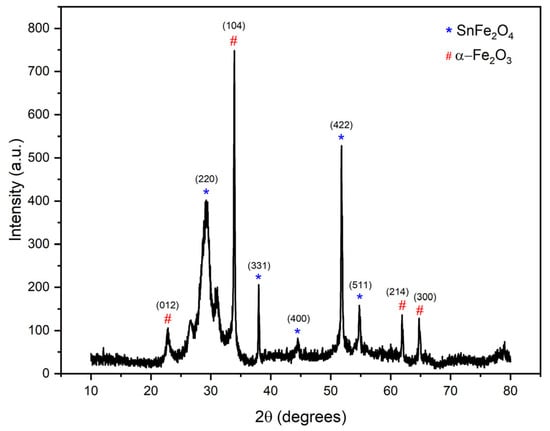
Figure 1.
The X-ray diffraction (XRD) patterns of SnFe2O4 nanoparticles.
As illustrated by the XRD pattern in Figure 1, the analysis confirms the presence of both the SnFe2O4 spinel phase and α-Fe2O3 (hematite). The coexistence of these two phases is commonly reported in the literature for ferrite-based materials, particularly under atmospheric co-precipitation conditions [36,42,43,44].
For instance, Wahab et al. [45] reported characteristic peaks for α-Fe2O3 at 2θ values of 23.70°, 32.70°, 35.10°, 40.40°, 43.35°, 49.05°, 53.60°, 57.10°, 62.00°, 63.70°, 69.02°, 71.65°, and 75.10°. Similar diffraction patterns were also reported by Zainuri [46] and Akhgar [47], confirming the formation of hematite through aqueous co-precipitation.
In our study, four peaks—22.84° (012), 33.92° (104), 61.90° (440), and 64.74° (300)—match those reported for α-Fe2O3. The dominant reflections observed at 29.22° (220), 37.98° (331), 44.50° (400), 51.80° (422), and 54.76° (511) align well with the studies [32,33,34,35], confirming the formation of the SnFe2O4 spinel phase.
The presence of hematite is attributed to the partial oxidation of Fe2+ during synthesis in ambient conditions, a known challenge in co-precipitation methods not conducted under inert atmospheres. While argon-assisted synthesis may reduce such impurities, our approach intentionally reflects practical and scalable methodologies. Nonetheless, argon-assisted synthesis will be explored in a future work to further improve the phase purity and catalytic performance of SnFe2O4.
The average crystallite size (D) of the nanoparticles was calculated using the Debye–Scherrer Equation (3) [43]:
where λ is the wavelength of the X-rays used (Cu Kα = 0.15406 nm), β is the full width at half maximum (FWHM) of the diffraction peak, θ is the Bragg diffraction angle, and k is the shape factor, typically assumed to be 0.98. Using this equation, the average crystallite sizes of the phases obtained in the SnFe2O4 catalyst were determined, as summarized in Table 1.

Table 1.
Oxide types and calculated crystallite sizes of the phases.
As summarized in Table 1, the SnFe2O4 phase exhibited crystallite sizes ranging from 5.54 nm (2θ = 29.22°) to 43.95 nm (2θ = 37.98°), with most values falling in the nanometric range between ~24 and 44 nm. The average crystallite size across the major SnFe2O4 peaks was approximately 25.11 nm, indicating a well-developed nanocrystalline spinel structure. This nanometric scale plays a critical role in the catalytic performance of SnFe2O4. Smaller crystallites generally provide a higher surface-to-volume ratio, enhancing the accessibility of active sites and improving catalytic efficiency. Furthermore, the presence of crystallites in the range of ~5–40 nm supports a mesoporous morphology, as also confirmed by BET analysis, which promotes effective mass transfer during the glycerol esterification reaction. The nanocrystalline structure thus contributes significantly to the observed high glycerol conversion and the selective formation of diacetin and triacetin under mild reaction conditions.
The specific surface area of the SnFe2O4 sample was measured using nitrogen (N2) adsorption–desorption isotherms, as shown in Figure 2, and was found to be 79.687 m2/g. Additionally, the pore diameter and pore volume were determined to be 8.627 nm and 0.188 cm3/g, respectively. These values are similar to those of other catalysts that showed a similar performance in the glycerol acetylation process [48]. The N2 adsorption–desorption isotherm of the SnFe2O4 magnetic nanoparticles corresponds to a type IV isotherm, characteristic of mesoporous materials according to the IUPAC classification, indicating the presence of well-defined mesopores [41,42,43]. The hysteresis loop observed at a high relative pressure (P/P0) of 0.7–1.0, categorized as type H2, suggests the presence of “big belly”-shaped pores, which are characteristic of ink-bottle-type pores; these pores typically having an uneven spatial structure [44].
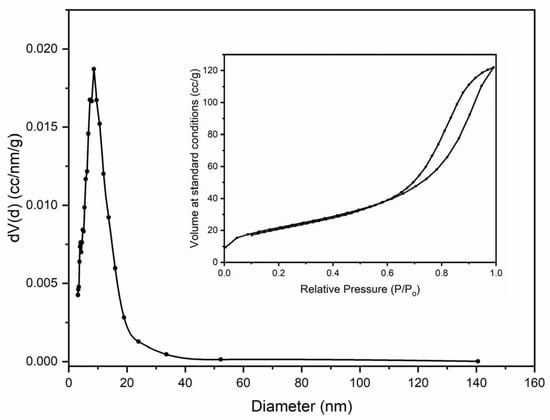
Figure 2.
Pore size distribution and N2 adsorption–desorption isotherms for SnFe2O4 magnetic nanoparticles.
The TGA-DTG analysis results for the nanoparticles prepared by precipitation, both before and after calcination at 500 °C, are presented in Figure 3. The uncalcined sample pre-dried at 150 °C exhibited weight loss in three distinct regions. The first region, in the temperature range of 30–150 °C, showed a weight loss of approximately 2%, which corresponds to the removal of surface-adsorbed water, even though the sample was pre-dried at 150 °C. The second region, between 150 and 250 °C, and the third region, spanning from 250 to 550 °C, displayed weight losses of around 12% and 27%, respectively. These weight losses are attributed to the removal of water, the gradual loss of hydroxyl groups [49], and the crystallization of the magnetic tin ferrite nanoparticles (SnFe2O4) [29]. At temperatures above 500 °C, the sample exhibited stable thermal behavior, suggesting that SnFe2O4 nanoparticles maintain thermal stability beyond this point. Based on these results, the calcination temperature was set at 500 °C. After calcination, the TGA analysis revealed a total weight loss of approximately 4.25% in the temperature range of 25–500 °C. This weight loss can be attributed to the release of water and gases absorbed from the atmosphere during cooling after calcination, as well as the decomposition of residual hydroxyl group chemical bonds. Additionally, an exothermic transformation was observed between 500 and 700 °C, potentially indicating phase transitions in the crystal structure of the nanoparticles [50].
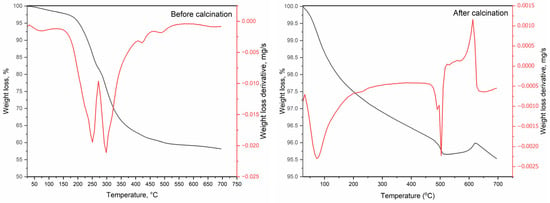
Figure 3.
TGA-DTG analysis of the nanoparticles before (left) and after (right) calcination (black line—weight loss %; red line—weight loss derivative, mg/s).
Figure 4 presents the FT-IR spectrum of SnFe2O4 nanoparticles in the wavenumber range of 400–4000 cm−1. A characteristic vibration peak is observed in the 400–500 cm−1 region, specifically around 460 cm−1, corresponding to the intrinsic vibrations of metal–oxygen bonds (Sn–O) at octahedral sites. Similarly, a peak around 580 cm−1 in the 500–600 cm−1 region corresponds to the intrinsic vibrations of Fe–O bonds at tetrahedral sites [28,38,43]. In addition, the peak around at 1022 cm−1 is due to the (Sn–OH) vibrations [51]. The absorption band between 1380 and 1480 cm−1 indicates the presence of hydroxyl (OH−) functional groups, likely due to the incomplete oxidation of the catalyst. In the 1600–1650 cm−1 region, the vibration is attributed to Fe–OH bending bonds, possibly resulting from the incomplete oxidation of iron, leading to the formation of iron hydroxide. Additionally, a strong O=C=O stretch at 2360 cm−1 is observed in the 2000–2400 cm−1 range, which may be due to CO2 absorption from the atmosphere. In the 3000–4000 cm−1 region, the broad peak at 3420 cm−1 suggests hydrogen bonding, confirming the presence of water (H2O) molecules in the sample [28,38,43].
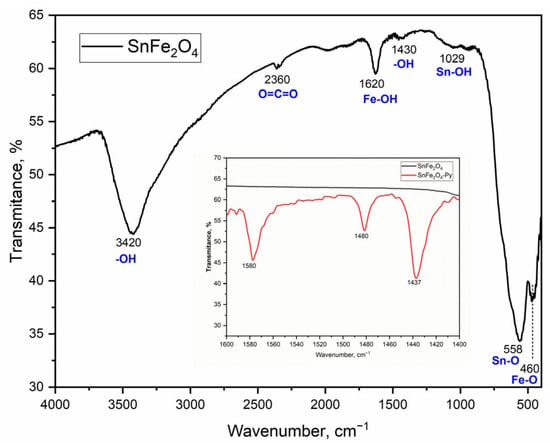
Figure 4.
The FTIR spectra and FTIR-Py of SnFe2O4 nanoparticles.
The acidic properties of the catalyst were further investigated using FT-IR pyridine adsorption (Figure 4). Pyridine was adsorbed onto 0.5 g of the catalyst for 6 h in a sealed capsule at room temperature. The sample was then heated at 115 °C for 2 h in a laboratory oven before being analyzed using infrared spectroscopy. The FTIR spectrum revealed three major absorption bands at 1580, 1480, and 1437 cm−1 [52,53]. The band at 1580 cm−1 corresponds to Brønsted acid sites, indicating pyridinium ion formation, while the band at 1437 cm−1 is associated with pyridine coordinated to Lewis acid sites [30,54]. The peak at 1480 cm−1 corresponds to overlapping vibrations of pyridine adsorbed on both Brønsted and Lewis acid sites. Using the equation reported by Emeis [55], the concentrations of Brønsted and Lewis acid sites were calculated based on the intensities and extinction coefficients of the respective bands, using Equations (4) and(5).
where CL and CB (μmol/g) are the concentrations of L and B acid sites; A1445 and A1543 are the integrated areas of the bands at 1445 and 1543 cm−1; and IMECL and IMECB are the integration molar extinction coefficients, 2.22 and 1.67 cm/μmol, respectively. r (cm) is the wafer radius, and w (g) is the wafer weight.
The concentrations of Brønsted and Lewis acid sites were found to be 73.47 μmol/g and 83.62 µmol/g, respectively, values close to those of other catalysts that have shown high performance in the esterification process of glycerin with acetic acid [56]. At the same time, the molar ratio between Brønsted and Lewis acid centers is slightly sub-unitary (0.88), similar to the values obtained in the literature, indicating an optimal acidity for glycerin esterification processes [56].
The catalytic efficiency of SnFe2O4 in glycerol esterification is closely governed by the nature and balance of Brønsted and Lewis acid sites present on its surface. A near-equimolar distribution of these sites plays a pivotal role in facilitating the stepwise esterification pathway that leads to the formation of monoacetin (MAG), diacetin (DAG), and triacetin (TAG). Brønsted acid sites function by donating protons (H+), thereby activating acetic acid molecules toward nucleophilic attack, a fundamental step in the initial conversion of glycerol to monoacetin. In parallel, Lewis acid sites act as electron-pair acceptors, forming coordination complexes with the hydroxyl groups of glycerol, increasing the electrophilicity of the substrate and accelerating subsequent acylation steps toward DAG and TAG [57]. Reports in the literature confirm that such Lewis acidity in heterogeneous catalysts enhances glycerol reactivity and promotes the formation of higher esters [58]. The cooperative action between Brønsted and Lewis sites in SnFe2O4 not only ensures high glycerol conversion but also favors improved selectivity toward diacetin and triacetin. This dual-acidity characteristic renders SnFe2O4 particularly effective in catalyzing the multistep and thermodynamically reversible esterification of glycerol under relatively mild conditions, as validated by both the experimental data and response surface modeling presented in this study.
To investigate the surface morphology of the tin ferrite nanoparticles, scanning electron microscope (SEM) images were captured (Figure 5). The SEM images of the synthesized nanoparticle sample reveal polyhedral nanostructures with cubic grains. However, the grain shapes appear to be somewhat inconsistent. The average grain size of the sample was found to be between 16 and 42 nm, with a few larger grains. This variation in grain size is attributed to the tin ferrite (SnFe2O4) composition.
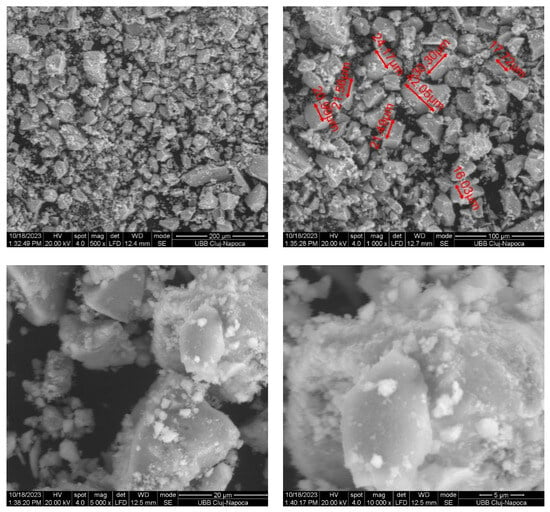
Figure 5.
SEM microphotographs of SnFe2O4 nanoparticles.
3.2. Evaluation of Catalyst Performance Using Box–Behnken Design Techniques
The glycerol acetylation was studied in a batch reactor over an FeSn catalyst. To evaluate the catalyst performance, a Box–Behnken design, considering reaction temperature, the molar ratio between acetic acid and glycerol (AA/G), and the catalyst amount (% in respect to glycerol) as process factors, was used. The reaction time for the data used in the modeling study was 240 min, and the process responses were the glycerol conversion (Y1) and the three reaction products: monoacetin (Y2), diacetin (Y3), and triacetin (Y4).
The coded values of the factors corresponding to a Box–Behnken experimental design matrix together with the process responses are given in Table 2.

Table 2.
The factors and experimental results matrix for Box–Behnken design.
Based on the preliminary experiments, the ranges for the main factors influencing the process were chosen to be between 85 and 115 °C for temperature, a catalyst amount between 1 and 2 % (by weight), and an initial acetic-acid (AA)-to-glycerol (GLY) ratio between 3 and 3.6. This selection was particularly relevant in the case of the AA-to-GLY ratio, as the primary objective was to achieve high yields of diacetin and triacetin, which represent the most valuable acetins from both practical and industrial perspectives. Accordingly, the chosen molar ratios of 3.0, 3.3, and 3.6 were grounded in stoichiometric considerations and designed to explore the influence of excess acetic acid on driving the equilibrium toward product formation. At AA-to-GLY ratios below 3.0, glycerol conversion and the formation of higher esters such as diacetin and triacetin were substantially limited due to the insufficient availability of acetic acid to shift the reversible esterification reaction forward.
Additionally, temperatures of 85 °C, 100 °C, and 115 °C were selected based on preliminary experimental screening insights from the relevant literature and prior expertise in esterification and organic synthesis involving glycerol and acetic acid [33]. The lower limit of 85 °C was experimentally identified as the minimum effective temperature at which noticeable catalytic activity of SnFe2O4 could be observed, as below this threshold, the activation energy required for esterification is insufficient to drive the reaction efficiently, particularly considering the high viscosity of glycerol and the moderate acidity of acetic acid. Support from kinetic studies shows that the activation energy for glycerol–acetic acid esterification typically ranges between 22 and 25 kJ/mol at around 100 °C and that conversion significantly drops at lower temperatures due to the reduced thermal driving force [16]. In addition, the high viscosity of glycerol inherently limits molecular diffusion, especially under low-temperature conditions, which further hinders the reaction rate, and this behavior aligns with the Stokes–Einstein relationship describing the inverse correlation between viscosity and diffusion coefficients [59]. An upper limit of 115 °C was chosen with respect to the boiling point of acetic acid (118 °C) under atmospheric pressure to ensure a safe and stable operation within our batch reactor equipped with Dean–Stark apparatus and a reflux condenser, and 115 °C was set as the maximum feasible temperature since exceeding this value would result in excessive acetic acid vaporization, leading to stoichiometric imbalance and loss of reaction control. The inclusion of an intermediate value of 100 °C enabled the observation of thermal transition behavior and allowed for the evaluation of potential nonlinear effects on glycerol conversion and acetin selectivity using the Box–Behnken design. Therefore, the selected temperature range of 85 to 115 °C represents a rational and operationally safe experimental window that balances catalytic activation catalyst stability and reactor constraints while ensuring statistical robustness in the optimization.
The experimental design matrix consists of 15 experiments, among which 3 are in the center of the experiment (experiments 7, 8, and 9 in Table 2). The values of the variables implemented in our study are given in Table 3.

Table 3.
Values of process factors used in experimental design matrix.
3.3. Effect of Process Variables
In order to evaluate the catalyst activity, reactions have been carried out at different reaction times, and the results are presented in Figure 6 and Figure 7. For an AA/GLY molar ratio of 3.6 and a catalyst amount of 1.5%, an increase in the reaction temperature from 85 to 115 °C has a positive effect on both the GLY conversion and acetin yields (Figure 6).
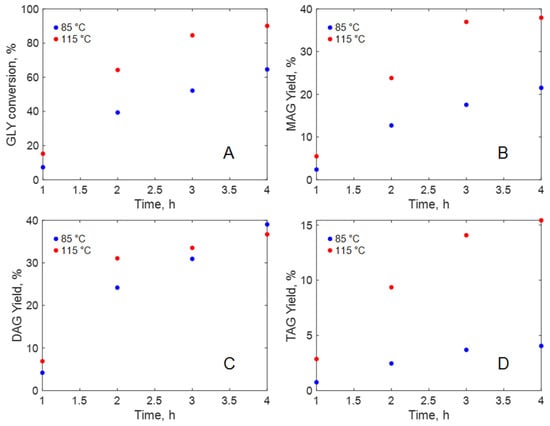
Figure 6.
Influence of reaction temperature on acetylation performance (AA/GLY = 3.6; catalyst amount 1.5%). (A) glycerol conversion; (B) monoacetin yield; (C) diacetin yield; (D) triacetin yield.
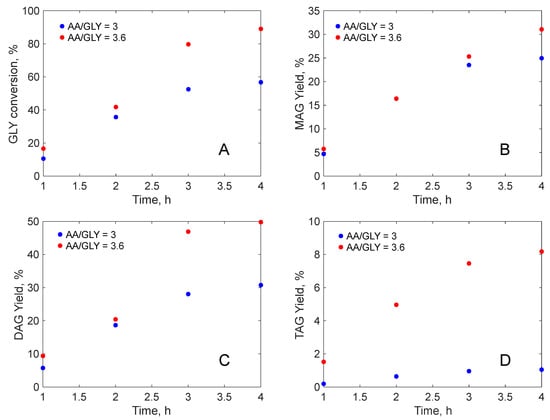
Figure 7.
Influence of AA/GLY ratio (temperature 100 °C; catalyst amount 2%) on: (A) glycerol conversion, (B) monoacetin yield, (C) diacetin yield, and (D) triacetin yield.
For a reaction temperature of 100 °C and a catalyst amount of 2%, an increase in the AA/GLY ration from 3 to 3.6 has a positive effect on both the GLY conversion and acetin yields (Figure 7).
The modeling by experimental design was performed only for the experimental results at a reaction time of 4 h. Given these results, at low temperature (85 °C) and a AA/GLY molar ratio of 3.3, the increase in the amount of catalyst has an important effect on both the GLY conversion (34.81% at 1% vs. 56.2% at 2%) and MAG yield (10.89 at 1% vs. 24.94% at 2%) and a slightly smaller effect on DAG (23.09% at 1% vs. 36.8% at 2%) and TAG yield (1.82 % at 1% vs. 3.25% at 2%) (see experiments 1 and 13 in Table 2). With an increase in temperature at 100 °C and using an AA/GLY ratio of 3, an increase in catalyst amount leads to a slight increase in GLY conversion but an important increase in MAG yield (18.9% at 1% vs. 24.9 at 2%) (experiments 6 and 2 in Table 2). The temperature increase has a positive effect on GLY conversion, also leading to an increase in the DAG and TAG yields, as evidenced by experiments 1 and 12 in Table 2. This is due to the increase in reaction rates with temperature.
3.4. Modeling of Process Performance
The main influences of the factors on acetin’ yields and GLY conversion can be evaluated based on a regression model, with the mathematical form given by relation (6).
The accuracy of this polynomial model was evaluated using ANOVA techniques. In order to assess the adequacy of this empirical model at a 95% confidence level, the value of the theoretical Fischer variable (Ft(p-1, n-p)) was compared with the test value (F-value) (where n—number of experiments and p—number of terms in the model) [60]. Based on these data, the p-value was calculated, a parameter that should be below 0.05, to assess that each factor is useful to predict the Y-responses [61]. The calculation of the coefficients was carried out by using Design-Expert Version 8.0.7.
For each of the four responses (Y1 to Y4), the Box–Behnken experimental matrix is given in Table 4 This experimental design approach proved to be appropriate, as reported in other studies in the literature [62].

Table 4.
Statistical parameters for evaluating model adequacy.
The empirical models’ coefficients, together with their confidence intervals, are provided in Table 5. Also, the full ANOVA tables are provided in the Supplementary Information File (Tables S1–S4).

Table 5.
Coefficient of the polynomial models and their confidence intervals.
The estimated coefficients given in Table 5 represent the main interactions, the binary interactions, and the quadratic interactions between factors. To evaluate the statistical meaning of these coefficients, the p-value parameter was calculated and the coefficients with no proper significance were eliminated, except for the ones involved in interactions, which were preserved to keep the model’s hierarchy.
In the experimental design, the magnitude of coefficients for coded variables reflects the relative influence of each factor on the response variable. A positive coefficient indicates that the response increases with the factor, while a negative coefficient suggests a decrease [63]. The adequacy of the models given by Equation (1) with the parameters in Table 5 is supported by correlation coefficients approaching unity (Table 4) and the close alignment between the predicted and experimental values illustrated in the parity plot (Figure 8). These results demonstrate that the proposed models provide a reliable representation of the process behavior.
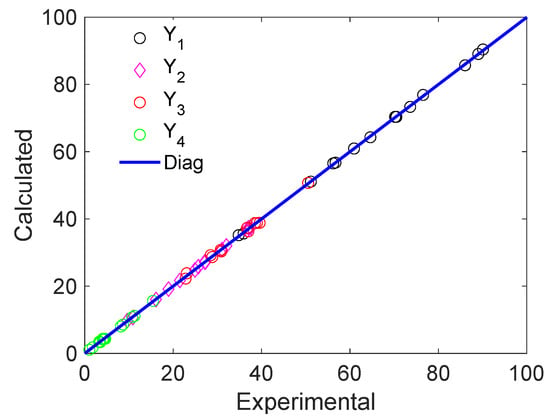
Figure 8.
Parity diagram for process responses.
One aspect that is worth mentioning is that catalyst amount, temperature, and the AA/GLY ratio are factors that improve both the glycerol conversion (Figure 9) and the yield in monoacetin (Figure 10) and triacetin, whereas the diacetin yield presents a maximum with respect to the AA/GLY ratio and temperature (Figure 11) due to the reversible behavior of the reaction system; triacetin yields are presented in Figure 12. This trend is clearly illustrated by the experimental data. For instance, at 85 °C and an AA/GLY molar ratio of 3.3, increasing the catalyst concentration from 1.0% to 2.0% led to an increase in glycerol conversion from 34.81% to 56.21%, accompanied by a rise in the yields of MAG (from 10.89% to 16.12%), DAG (from 23.10% to 36.83%), and TAG (from 1.83% to 3.27%). Moreover, at higher temperatures such as 115 °C, enhanced performance was observed. In run 4, using 1.5% catalyst and AA/GLY = 3.6, the conversion reached 90.08% with balanced yields of MAG (37.55%), DAG (36.70%), and TAG (15.44%). In run 8, under a similar temperature but with 2.0% catalyst and a slightly lower AA/GLY ratio (3.3), the conversion remained high (86.03%) while the selectivity shifted toward DAG (39.56%) and lower TAG (10.75%). These results confirm the synergistic influence of temperature and catalyst concentration on shifting the esterification sequence toward higher acetins and maximizing glycerol valorization.
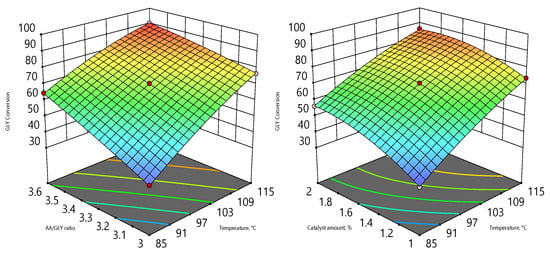
Figure 9.
Variation in glycerol (GLY) conversion with process factors (dots—experimental values; lines—response surface).
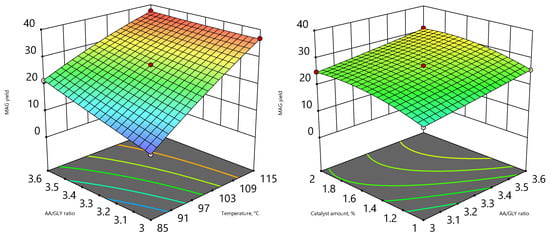
Figure 10.
Variation in MAG yield with process factors (dots—experimental values; lines—response surface).
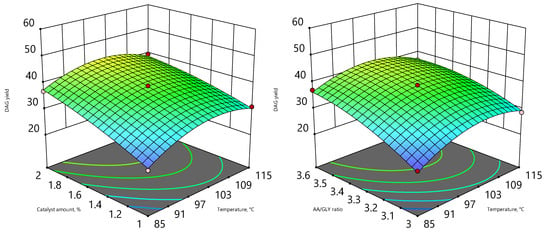
Figure 11.
Variation in DAG yield with process factors (dots—experimental values; lines—response surface).
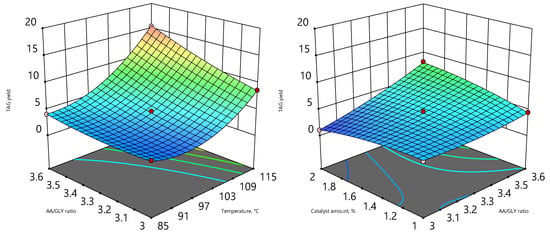
Figure 12.
Variation in TAG yield with process factors (dots—experimental values; lines—response surface).
The data in Table 6 were obtained using the proposed mathematical models. The goal of this optimization study is to achieve the simultaneous maximization of the conversion of glycerol and yields in superior acetins (DAG and TAG), along with the simultaneous minimization of MAG. According to the optimization results and the desirability plots provided in the Supplementary Information File (Figures S1–S3), the solution in Table 6 is the best available given the imposed restrictions.

Table 6.
Optimum parameters for maximum values of GLY conversion and DAG and TAG yield.
The maximum GLY conversion (93.2%) was obtained at 110 °C, a 2% catalyst amount, and an AA/GLY molar ratio of 2. These parameters give a cumulated DAG and TAG yield of about 60%.
To evaluate the reusability and stability of the SnFe2O4 nanocatalyst, the esterification of glycerol was performed over four consecutive cycles under optimized conditions (115 °C, acetic-acid-to-glycerol molar ratio of 3.6, and 2 wt.% catalyst). After each cycle, the catalyst was magnetically recovered, thoroughly washed with ethanol to remove adsorbed organic residues, and dried at 100 °C for one hour prior to reuse.
As shown in Figure 13, the catalyst maintained good catalytic activity throughout the recycling tests. Glycerol conversion exhibited only a slight decrease, from 89% in the first cycle to 85% in the fourth, indicating the preservation of the catalyst’s structural integrity and surface functionality. However, a more noticeable decline was observed in the diacetin yield, which decreased from 50.5% to 40%, while the monoacetin yield increased from 8.2% to 18%. This shift suggests a gradual depletion of accessible strong acid sites or possible surface deactivation during repeated use and regeneration.
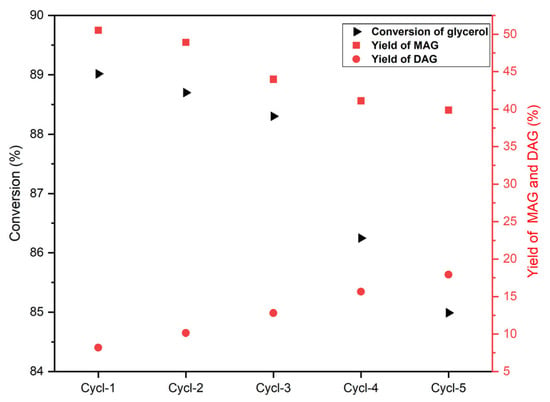
Figure 13.
Reusability results for tin ferrite catalyst over 5 cycles.
Importantly, no evidence of catalyst agglomeration or significant deactivation was detected, confirming the robustness of SnFe2O4 under the applied operational and regeneration protocols. The combination of sustained activity, selectivity stability, and convenient magnetic recovery underscores the suitability of this nanocatalyst for environmentally friendly and economically viable glycerol upgrading processes.
4. Conclusions
The magnetic SnFe2O4 catalyst synthesized by chemical co-precipitation presented physicochemical characteristics of interest for the esterification process of glycerol with acetic acid. Thus, the textural characteristics present values close to those of other catalysts that have performed in the esterification process of glycerol with acetic acid. At the same time, weight losses, highlighted by TGA analysis, can mainly be attributed to the homolytic breaking of the residual chemical bonds of the hydroxyl groups and the exothermic transformation between 500 and 700 °C, indicating potential phase transitions in the crystalline structure of the nanoparticles. X-ray diffraction indicates a high degree of crystallinity of the SnFe2O4 nanoparticles.
The concentrations of Brønsted and Lewis acid sites and the value of the molar ratio between Brønsted and Lewis acid centers present values close to those of other catalysts that have demonstrated high performances in the esterification process of glycerol with acetic acid.
These characteristics were found in high performances of the direct esterification process of glycerin with acetic acid. Thus, working in a batch system, at a relatively low catalyst concentration (max. 2%), with minimum initial reactant ratios of 3 and temperatures above 85 °C, glycerol conversions were up to 90%, and the maximum yields in acetins at reaction times of 4 h were 37% for monoacetin, 39% for diacetin, and 11% for triacetin.
Supplementary Materials
The following supporting information can be downloaded at: https://www.mdpi.com/article/10.3390/chemengineering9040086/s1, Table S1: ANOVA for Quadratic model corresponding to Response Y1; Table S2: ANOVA for Quadratic model corresponding to Response Y2; Table S3: ANOVA for Quadratic model corresponding to Response Y3; Table S4: ANOVA for Quadratic model corresponding to Response Y3; Figure S1: Desirability plot in respect to X1 and X2 factors; Figure S2: Desirability plot in respect to X1 and X3 factors; Figure S3: Desirability plot in respect to X2 and X3 factors.
Author Contributions
Conceptualization, R.D., A.-C.J., G.V. and D.B.; methodology, R.D., M.B. and I.B.; software, I.B. and R.G.; validation, R.D., I.B. and R.G.; formal analysis, M.B, A.B., I.O and R.D.; investigation, I.V.G., G.V., A.B. and R.D.; resources, I.B., R.G., A.B., C.P. and R.D.; data curation, R.D., I.B., R.G., A.B. and D.B.; writing—original draft preparation, R.D., I.B., A.-C.J. and R.G.; writing—review and editing, R.D. and I.V.G.; visualization, D.B., C.P., I.O. and M.B.; supervision, I.B., R.D. and A.B.; project administration, R.D.; funding acquisition, I.B. All authors have read and agreed to the published version of the manuscript.
Funding
This work was supported by a grant from the National Program for Research of the National Association of Technical Universities—GNAC ARUT 2023, project: “Innovative techniques for glycerol esterification with acetic acid- GLYWALL”, contract no. 43/09.10.2023.
Data Availability Statement
Data are contained within the article.
Conflicts of Interest
The authors declare no conflict of interest.
References
- Dusescu, C.; Rosca, P.; Bombos, D.; Juganaru, T.; Popovici, D.; Dragomir, R. Hydrogen from Glycerol by Steam Reforming. Rev. Chim. 2012, 63, 229–231. [Google Scholar]
- Dusescu, C.; Bolocan, I. The Glycerol Hydrogenolysis on New Supported Catalysts. Rev. Chim. 2012, 63, 305–309. [Google Scholar]
- Dusescu, C.; Bolocan, I. New Catalysts for the Glycerol Hydrogenolysis. Rev. Chim. 2012, 63, 732–738. [Google Scholar]
- Almeida, E.L.; Olivo, J.E.; Andrade, C.M.G. Production of Biofuels from Glycerol from the Biodiesel Production Process-A Brief Review. Fermentation 2023, 9, 18. [Google Scholar] [CrossRef]
- Wan, T.; Lin, Y.; Tu, Y. Plasticizing effect of glyceryl tribenzoate, dipropylene glycol dibenzoate, and glyceryl triacetate on poly(lactic acid). Polym. Eng. Sci. 2016, 56, 1399–1406. [Google Scholar] [CrossRef]
- Murariu, M.; Ferreira, A.D.S.; Alexandre, M.; Dubois, P. Polylactide (PLA) designed with desired end-use properties: 1. PLA compositions with low molecular weight ester-like plasticizers and related performances. Polym. Adv. Technol. 2008, 19, 636–646. [Google Scholar] [CrossRef]
- Fiume, M. Final Report on the Safety Assessment of Triacetin. Int. J. Toxicol. 2003, 22, 1–10. [Google Scholar] [CrossRef]
- Herrera, N.; Mathew, A.P.; Oksman, K. Plasticized polylactic acid/cellulose nanocomposites prepared using melt-extrusion and liquid feeding: Mechanical, thermal and optical properties. Compos. Sci. Technol. 2015, 106, 149–155. [Google Scholar] [CrossRef]
- Arias, V.; Höglund, A.; Odelius, K.; Albertsson, A.-C. Polylactides with “green” plasticizers: Influence of isomer composition. J. Appl. Polym. Sci. 2013, 130, 2962–2970. [Google Scholar] [CrossRef]
- Singh, A.A.; Sharma, S.; Srivastava, M.; Majumdar, A. Modulating the properties of polylactic acid for packaging applications using biobased plasticizers and naturally obtained fillers. Int. J. Biol. Macromol. 2020, 153, 1165–1175. [Google Scholar] [CrossRef]
- Salas-Papayanopolos, H.; Morales-Cepeda, A.B.; Sanchez, S.; Lafleur, P.G.; Gomez, I. Synergistic effect of silver nanoparticle content on the optical and thermo-mechanical properties of poly(l-lactic acid)/glycerol triacetate blends. Polym. Bull. 2017, 74, 4799–4814. [Google Scholar] [CrossRef]
- Merli, G.; Becci, A.; Amato, A.; Beolchini, F. Acetic acid bioproduction: The technological innovation change. Sci. Total Environ. 2021, 798, 149292. [Google Scholar] [CrossRef]
- Keogh, J.; Inrirai, P.; Artioli, N.; Manyar, H. Nanostructured Solid/Liquid Acid Catalysts for Glycerol Esterification: The Key to Convert Liability into Assets. Nanomaterials 2024, 14, 615. [Google Scholar] [CrossRef] [PubMed]
- Abida, K.; Ali, A. A review on catalytic role of heterogeneous acidic catalysts during glycerol acetylation to yield acetins. J. Indian Chem. Soc. 2022, 99, 100459. [Google Scholar] [CrossRef]
- Gupta, P.; Paul, S. Solid acids: Green alternatives for acid catalysis. Catal. Today 2014, 236, 153–170. [Google Scholar] [CrossRef]
- Keogh, J.; Jeffrey, C.; Tiwari, M.S.; Manyar, H. Kinetic Analysis of Glycerol Esterification Using Tin Exchanged Tungstophosphoric Acid on K-10. Ind. Eng. Chem. Res. 2023, 62, 19095–19103. [Google Scholar] [CrossRef] [PubMed]
- Liu, X.M.; Ma, H.Y.; Wu, Y.; Wang, C.; Yang, M.A.; Yan, P.F.; Welz-Biermann, U. Esterification of glycerol with acetic acid using double SO3H-functionalized ionic liquids as recoverable catalysts. Green Chem. 2011, 13, 697–701. [Google Scholar] [CrossRef]
- Li, L.; Yu, S.-T.; Xie, C.-X.; Liu, F.-S.; Li, H.-J. Synthesis of glycerol triacetate using functionalized ionic liquid as catalyst. J. Chem. Technol. Biotechnol. 2009, 84, 1649–1652. [Google Scholar] [CrossRef]
- Liu, S.; Wang, A.; Liu, Z.; Li, L.; Yu, S.; Xie, C.; Liu, F. Synthesis of Glycerol Triacetate Using a Brønsted–Lewis Acidic Ionic Liquid as the Catalyst. J. Am. Oil Chem. Soc. 2015, 92, 1253–1258. [Google Scholar] [CrossRef]
- Huang, M.Y.; Han, X.X.; Hung, C.T.; Lin, J.C.; Wu, P.H.; Wu, J.C.; Liu, S.B. Heteropolyacid-based ionic liquids as efficient homogeneous catalysts for acetylation of glycerol. J. Catal. 2014, 320, 42–51. [Google Scholar] [CrossRef]
- Gujjala, L.K.S.; Kundu, D.; Dutta, D.; Kumar, A.; Bal, M.; Kumar, A.; Singh, E.; Mishra, R.; Kumar, S.; Vo, D.-V.N. Advances in ionic liquids: Synthesis, environmental remediation and reusability. J. Mol. Liq. 2024, 396, 123896. [Google Scholar] [CrossRef]
- Kong, P.S.; Aroua, M.K.; Daud, W.M.A.W.; Lee, H.V.; Cognet, P.; Pérès, Y. Catalytic role of solid acid catalysts in glycerol acetylation for the production of bio-additives: A review. RSC Adv. 2016, 6, 68885–68905. [Google Scholar] [CrossRef]
- Hu, W.; Zhang, Y.; Huang, Y.; Wang, J.; Gao, J.; Xu, J. Selective esterification of glycerol with acetic acid to diacetin using antimony pentoxide as reusable catalyst. J. Energy Chem. 2015, 24, 632–636. [Google Scholar] [CrossRef]
- Kulkarni, R.M.; Dhanyashree, J.K.; Varma, E.; Sirivibha, S.P. Microwave assisted glycerol esterification using CeO2, ZrO2, mixed metal oxide catalyst. Mater. Today Proc. 2024, 102, 416–427. [Google Scholar] [CrossRef]
- Sun, J.Y.; Tong, X.L.; Yu, L.H.; Wan, J. An efficient and sustainable production of triacetin from the acetylation of glycerol using magnetic solid acid catalysts under mild conditions. Catal. Today 2016, 264, 115–122. [Google Scholar] [CrossRef]
- Reddy, P.S.; Sudarsanam, P.; Raju, G.; Reddy, B.M. Synthesis of bio-additives: Acetylation of glycerol over zirconia-based solid acid catalysts. Catal. Commun. 2010, 11, 1224–1228. [Google Scholar] [CrossRef]
- Wang, B.; Wang, B.; Shukla, S.K.; Wang, R. Enabling Catalysts for Biodiesel Production via Transesterification. Catalysts 2023, 13, 740. [Google Scholar] [CrossRef]
- Esmaili, S.; Khazaei, A.; Ghorbani-Choghamarani, A.; Mohammadi, M. Silica sulfuric acid coated on SnFe2O4 MNPs: Synthesis, characterization and catalytic applications in the synthesis of polyhydroquinolines. RSC Adv. 2022, 12, 14397–14410. [Google Scholar] [CrossRef]
- Liu, F.; Li, T.; Zheng, H. Structure and magnetic properties of SnFe2O4 nanoparticles. Phys. Lett. A 2004, 323, 305–309. [Google Scholar] [CrossRef]
- Doukeh, R.; Râpă, M.; Matei, E.; Prodan, D.; Győrgy, R.; Trifoi, A.; Banu, I. An Evaluation of Glycerol Acetalization with Benzaldehyde over a Ferromagnetic Heteropolyacid Catalyst. Catalysts 2023, 13, 782. [Google Scholar] [CrossRef]
- Smirnov, A.A.; Selishcheva, S.A.; Yakovlev, V.A. Acetalization Catalysts for Synthesis of Valuable Oxygenated Fuel Additives from Glycerol. Catalysts 2018, 8, 595. [Google Scholar] [CrossRef]
- Hasabnis, A.; Mahajani, S. Entrainer-Based Reactive Distillation for Esterification of Glycerol with Acetic Acid. Ind. Eng. Chem. Res. 2010, 49, 9058–9067. [Google Scholar] [CrossRef]
- Banu, I.; Bumbac, G.; Bombos, D.; Velea, S.; Gălan, A.-M.; Bozga, G. Glycerol acetylation with acetic acid over Purolite CT-275. Product yields and process kinetics. Renew. Energ. 2020, 148, 548–557. [Google Scholar] [CrossRef]
- Hussain, M.; Gassoumi, A.; Weinstein, I.A.; Kahshan, A.; Ahmad, K.; Henaish, A.M.A. Fabrication of high performance SnFe2O4@PANI electrocatalyst for Oxygen Evaluation Reaction (OER) by hydrothermal method. J. Sol-Gel Sci. Technol. 2024, 112, 322–331. [Google Scholar] [CrossRef]
- Jia, Y.; Kim, D.-H.; Lee, T.; Kang, S.; Lee, B.W.; Rhee, S.J.; Liu, C. One-pot solvothermal synthesis of magnetic SnFe2O4 nanoparticles and their performance in the photocatalytic degradation of chlortetracycline with visible light radiation. RSC Adv. 2016, 6, 76542–76550. [Google Scholar] [CrossRef]
- Lee, K.-T.; Lu, S.-Y. A cost-effective, stable, magnetically recyclable photocatalyst of ultra-high organic pollutant degradation efficiency: SnFe2O4 nanocrystals from a carrier solvent assisted interfacial reaction process. J. Mater. Chem. A 2015, 3, 12259–12267. [Google Scholar] [CrossRef]
- Han, H.; Luo, Y.; Jia, Y.; Hasan, N.; Liu, C. A review on SnFe2O4 and their composites: Synthesis, properties, and emerging applications. Prog. Nat. Sci. Mater. Int. 2022, 32, 517–527. [Google Scholar] [CrossRef]
- Lee, K.-T.; Liu, D.-M.; Lu, S.-Y. SnFe2O4 Nanocrystals as Highly Efficient Catalysts for Hydrogen-Peroxide Sensing. Chem. Eur. J. 2016, 22, 10877–10883. [Google Scholar] [CrossRef]
- Li, S.-S.; Li, W.-J.; Jiang, T.-J.; Liu, Z.-G.; Chen, X.; Cong, H.-P.; Liu, J.-H.; Huang, Y.-Y.; Li, L.-N.; Huang, X.-J. Iron Oxide with Different Crystal Phases (α- and γ-Fe2O3) in Electroanalysis and Ultrasensitive and Selective Detection of Lead(II): An Advancing Approach Using XPS and EXAFS. Anal. Chem. 2016, 88, 906–914. [Google Scholar] [CrossRef]
- Hjiri, M.; Zahmouli, N.; Khouzami, K.; Mir, L.E.; Aida, M.S.; Moulaee, K.; Lemine, O.M.; Leonardi, S.G.; Neri, G. A comparison of NO2 sensing characteristics of α- and γ-iron oxide-based solid-state gas sensors. Appl. Phys. A 2020, 126, 788. [Google Scholar] [CrossRef]
- Fardood, S.T.; Ramazani, A.; Golfar, Z.; Joo, S.W. Green Synthesis of α-Fe2O (hematite) Nanoparticles using Tragacanth Gel. J. Appl. Chem. Res. 2017, 11, 19–27. [Google Scholar]
- Sedaghati-Jamalabad, G.; Bagheri-Mohagheghi, M.M. Influence of synthesis route on structural properties of SnFe2O4 spinel phase via methods of co-precipitation, sol–gel and solvothermal: Morphology, phase analysis, crystallite size and lattice strain. Discov. Appl. Sci. 2024, 6, 202. [Google Scholar] [CrossRef]
- Sedaghati-Jamalabad, G.; Bagheri-Mohagheghi, M.M. A study on the structural and optical properties of the SnFe2O4 spinel compound as anode electrode in Li ion-battery: The optical and dielectric parameters via synthesis methods. Opt. Quantum Electron. 2024, 56, 965. [Google Scholar] [CrossRef]
- Elkahoui, Y.; Abahdou, F.-Z.; Ben Ali, M.; Alahiane, S.; Elhabacha, M.; Boutarba, Y.; El Hajjaji, S. Photocatalytic and Photo-Fenton-like Degradation of Cationic Dyes Using SnFe2O4/g-C3N4 Under LED Irradiation: Optimization by RSM-BBD and Artificial Neural Networks (ANNs). Reactions 2025, 6, 23. [Google Scholar] [CrossRef]
- Wahab, R.; Khan, F.; Al-Khedhairy, A.A. Hematite iron oxide nanoparticles: Apoptosis of myoblast cancer cells and their arithmetical assessment. RSC Adv. 2018, 8, 24750–24759. [Google Scholar] [CrossRef] [PubMed]
- Zainuri, M. Hematite from Natural Iron Stones as Microwave Absorbing Material on X-Band Frequency Ranges. IOP Conf. Ser. Mater. Sci. Eng. 2017, 196, 012008. [Google Scholar] [CrossRef]
- Akhgar, B.N. Comparing the Microstructural Changes of Mechanically Activated Hematite During Nano Zero-Valent Iron Preparation. J. Sustain. Metall. 2024, 10, 749–758. [Google Scholar] [CrossRef]
- Sargazi, S.; Hajinezhad, M.R.; Rahdar, A.; Zafar, M.N.; Awan, A.; Baino, F. Assessment of SnFe2O4 Nanoparticles for Potential Application in Theranostics: Synthesis, Characterization, In Vitro, and In Vivo Toxicity. Materials 2021, 14, 825. [Google Scholar] [CrossRef]
- Marinescu, M.; Ciuparu, D.; Bombos, D.; Dusescu-Vasile, C.M.; Popovici, R.D.; Matei, V. Hydrogenolysis of palm oil derived methyl esters over niobium and tungsten base catalysts. Stud. Univ. Babes-Bolyai Chem. 2023, 68, 71–98. [Google Scholar] [CrossRef]
- Banerjee, S.; Mukhopadhyay, P. (Eds.) Chapter 1—Phases and Crystal Structures. In Pergamon Materials Series; Pergamon: Oxford, UK, 2007; Volume 12, pp. 1–86. [Google Scholar]
- Malik, R.; Tomer, V.K.; Duhan, S.; Nehra, S.P.; Rana, P.S. One-Pot Hydrothermal Synthesis of Porous SnO2 Nanostructures for Photocatalytic Degradation of Organic Pollutants. Energy Environ. Focus 2015, 4, 340–345. [Google Scholar] [CrossRef]
- Topaloǧlu Yazıcı, D.; Bilgiç, C. Determining the surface acidic properties of solid catalysts by amine titration using Hammett indicators and FTIR-pyridine adsorption methods. Surf. Interface Anal. 2010, 42, 959–962. [Google Scholar] [CrossRef]
- Barzetti, T.; Selli, E.; Moscotti, D.; Forni, L. Pyridine and ammonia as probes for FTIR analysis of solid acid catalysts. J. Chem. Soc. Faraday Trans. 1996, 92, 1401–1407. [Google Scholar] [CrossRef]
- Xiao, H.; Zhang, J.; Wang, P.; Zhang, Z.; Zhang, Q.; Xie, H.; Yang, G.; Han, Y.; Tan, Y. Mechanistic insight to acidity effects of Ga/HZSM-5 on its activity for propane aromatization. RSC Adv. 2015, 5, 92222–92233. [Google Scholar] [CrossRef]
- Emeis, C.A. Determination of Integrated Molar Extinction Coefficients for Infrared Absorption Bands of Pyridine Adsorbed on Solid Acid Catalysts. J. Catal. 1993, 141, 347–354. [Google Scholar] [CrossRef]
- Zhu, S.; Zhu, Y.; Gao, X.; Mo, T.; Zhu, Y.; Li, Y. Production of bioadditives from glycerol esterification over zirconia supported heteropolyacids. Bioresour. Technol. 2013, 130, 45–51. [Google Scholar] [CrossRef] [PubMed]
- Tao, M.; Xue, L.; Sun, Z.; Wang, S.; Wang, X.; Shi, J. Tailoring the Synergistic Bronsted-Lewis acidic effects in Heteropolyacid catalysts: Applied in Esterification and Transesterification Reactions. Sci. Rep. 2015, 5, 13764. [Google Scholar] [CrossRef]
- Perez, F.M.; Gatti, M.N.; Santori, G.F.; Pompeo, F. Transformations of Glycerol into High-Value-Added Chemical Products: Ketalization and Esterification Reactions. Reactions 2023, 4, 569–634. [Google Scholar] [CrossRef]
- Chen, B.; Sigmund, E.E.; Halperin, W.P. Stokes-Einstein Relation in Supercooled Aqueous Solutions of Glycerol. Phys. Rev. Lett. 2006, 96, 145502. [Google Scholar] [CrossRef]
- Myers, R.H.; Montgomery, D.C.; Anderson-Cook, C. Response Surface Methodology Process and Product Optimization Using Designed Experiments, 4th ed.; John Wiley & Sons, Inc.: New York, NY, USA, 2016; p. xv, 825. [Google Scholar]
- Navidi, W. Statistics for Engineers and Scientists, 3rd ed.; McGraw-Hill: New York, NY, USA, 2011; p. 908. [Google Scholar]
- Matei, P.L.; Deleanu, I.; Brezoiu, A.M.; Chira, N.A.; Busuioc, C.; Isopencu, G.; Cîlțea-Udrescu, M.; Alexandrescu, E.; Stoica-Guzun, A. Ultrasound-Assisted Extraction of Blackberry Seed Oil: Optimization and Oil Characterization. Molecules 2023, 28, 2486. [Google Scholar] [CrossRef]
- Montgomery, D.C. Design and Analysis of Experiments, 10th ed.; Emea Edition; Wiley: Hoboken, NJ, USA, 2020; pp. x, 550, 592, 527, 552. [Google Scholar]
Disclaimer/Publisher’s Note: The statements, opinions and data contained in all publications are solely those of the individual author(s) and contributor(s) and not of MDPI and/or the editor(s). MDPI and/or the editor(s) disclaim responsibility for any injury to people or property resulting from any ideas, methods, instructions or products referred to in the content. |
© 2025 by the authors. Licensee MDPI, Basel, Switzerland. This article is an open access article distributed under the terms and conditions of the Creative Commons Attribution (CC BY) license (https://creativecommons.org/licenses/by/4.0/).